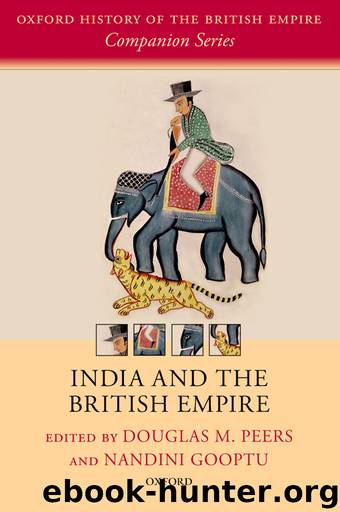India and the British Empire by Peers Douglas M.; Gooptu Nandini;

Author:Peers, Douglas M.; Gooptu, Nandini;
Language: eng
Format: epub
Publisher: Oxford University Press, Incorporated
Published: 2012-03-15T00:00:00+00:00
III. Indigenous Legal Knowledge
From the beginning of colonial rule, colonial courts ran alongside indigenous systems of justice that continued long after the establishment of extensive courts, and from the start, colonial legal machinery was dependent on South Asian legal officers. The East India Company, as we have noted, was for a while dependent on indigenous tribunals of arbitration, panchayats, and on indigenous intermediaries as vakils, muftis, pandits, and ulma (Muslim legal scholars). Colonial courts were staffed by Indian law officers, jurors, low-ranking clerks, and assistant judges. Indigenous elites navigated the legal changes inscribed by the colonial state in different ways, sometimes to reassert patriarchy, other times to advance social reforms and sometimes to challenge colonial rule. More South Asians were employed in the administration of law than in any other branch of the colonial state. The subordinate court officials, collectively gathered under the rubric amla, were the linchpin of the colonial courts—sarishtadars (head ministerial officer), translators, and muharrir (scribes) collectively undertook essential clerical duties, assisted the magistrate, kept records, executed the magistrates’ orders, wrote and copied perwanahs (court orders).28 The salaries of amlas in the subordinate courts was less than that earned by agricultural labourers, although they were skilled legal officers, knowledgeable in the laws and practice of the court, and higher grade amlas frequently carried out the duties of European colonial officers. These low salaries opened the possibility of corruption and compromised the efficiency of legal administration, and repeated but ultimately frustrated calls for improving the pay of indigenous court officers as an incentive for recruitment and as a barrier to corruption and abuse were heard.
Dependence on indigenous law officers was dictated by expediency but also by ideology. Central to the idea of the rule of law as a civilizing force was the notion that modern and sophisticated legal systems were a kind of moral education; the rule of law would help prepare Indians for self-government by training them in the art of citizenship. Pragmatic reasons to utilize indigenous legal knowledge contrasted with reluctance in some quarters to be dependent on indigenous officers or legal bodies. The shifting status of the panchayat illustrates this ambivalence. Village councils or panchayats were the primary pre-colonial site for judicial arbitration, and, although they continued after the conquest to decide on small claims, as well as caste disputes, in many areas they lost much of their traditional vigour or authority, partly because their rulings tended not to be enforced by the colonial state. The decline of the panchayat, already evident in the 1820s, was regretted by some colonial administrators like John Malcolm who saw these local tribunals as a way to make justice speedier and less costly and to bring law closer to the customs and practices of local societies: ‘no law of the state can so effectively reach the moral character of the natives as the panchayat’.29 But scepticism about the effectiveness and impartiality of the panchayat was also widely expressed; the Bengal Government argued in the 1830s against suggestions by the
Download
This site does not store any files on its server. We only index and link to content provided by other sites. Please contact the content providers to delete copyright contents if any and email us, we'll remove relevant links or contents immediately.
| Africa | Americas |
| Arctic & Antarctica | Asia |
| Australia & Oceania | Europe |
| Middle East | Russia |
| United States | World |
| Ancient Civilizations | Military |
| Historical Study & Educational Resources |
Life of Elizabeth I by Alison Weir(2026)
The Invisible Wall by Harry Bernstein(1764)
Art of Betrayal by Gordon Corera(1399)
1916 in 1966 by Mary E. Daly(1228)
Thunderstruck by Erik Larson(1181)
The Decline and Fall of the British Empire, 1781-1997 by Piers Brendon(1096)
A Brief History of Britain, 1066-1485 by Nicholas Vincent(1009)
A Brief History of Britain, 1485-1660 by Ronald Hutton(977)
Guy Burgess by Stewart Purvis(970)
Mary, Queen of Scots by Weir Alison(961)
Henry VIII by Alison Weir(909)
The Last Lion 02 - Winston Churchill - Alone, 1932-1940 by William Manchester(907)
Lang Lang by Lang Lang(833)
1066 by Andrew Bridgeford(829)
Gimson's Kings and Queens by Andrew Gimson(810)
The Last Plantagenet by Thomas B Costain(809)
Coalition by David Laws(806)
London: A Biography by Peter Ackroyd(802)
Diana by Andrew Morton(785)
